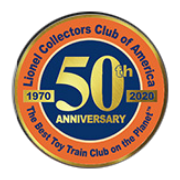Recap From Kansas City
Kansas City - 46th Convention July 25-30, 2016
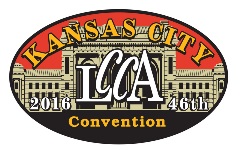
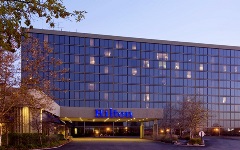
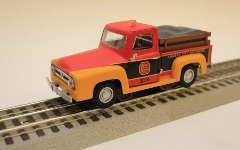
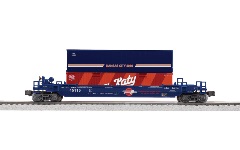
It had been 44 years since the LCCA has had a convention in Kansas City, MO. Many things have changed in 44 years. When it comes to the sights to see, we found new and different attractions to see and enjoy in Kansas City in 2016.
The most exciting promise for the 2016 convention: we would be able to ride the BNSF Special Train. BNSF made this outstanding train available to us ride from Argentine yard in Kansas City, Kansas to nearly Topeka, Kansas. This trip included a trip to the hump yards and watching all the action there. The train itself was full of polished brass and wood that make up this beautiful consist used by the executives and other special guests.
In addition to the modern and shiny train, Kansas City had an old and sunken steamboat. The Arabia Steamboat Museum has more than 200 tons of recovered treasure from the 1856 steamboat that sank in the Mississippi river.This museum has even been consulted by the Smithsonian because of its excellence in restoring artifacts. The tour was fantastic and we were able to see how hte restoration of these artifacts occur.
Kansas City is also home to the only World War I museum dedicated only to preserving the objects and personal experiences of the Great War. It was interesting, educational, and emotional. But the time allocated to see the museum was totally inadequate! A return trip is a must. We were able to take an elevator, plus 45 steps, to the top of the Liberty Memorial Tower for a scenic view of Kansas City and a great view of Union Station and the iconic Western Auto sign atop the Western Auto Building.
Without going into more detail, there was a lot to see and do in Kansas City, and I didn't even mentioned barbeque and the famous Burnt Ends of Kansas City BBQ. 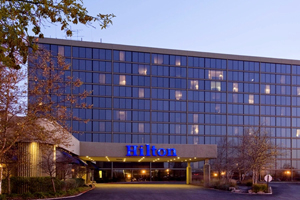
During the week we were guests at the KCI Airport Hilton hotel, where we were kept so busy with numerous activities, events, tours, and visiting with friends and fellow members that we wondered where the week went! This was a great hotel. This convention was not one to miss by any means.
In addition to the events and program, each attendee received several special items including the beautiful KCS motorized pickup registration gift and tables pilled high with Banquet Gifts. There were numerous surprises for attending specific events such as the souvenir BNSF container for those on the BNSF train ride and of course don’t forget items in the LCCA store available for purchase including the container on-site car.
We had scheduled social activities and events that enabled attendees to meet and visit with friends and fellow members. For example, there was a hospitality suite where attendees were able to gather and visit or work on puzzles or spend some free time getting acquainted with others. We started the week on Sunday evening with the President’s Welcoming Party for “cookies and milk” which is now nearly a full meal. On Wednesday, we hosted a First Timers’ Reception. On Thursday, we attended the famous Get Acquainted Party with a few surprises. Friday evening started the Trading Hall. On Saturday night, we attended the Banquet. There were a couple great workshops thrown in for good measure just in case you got bored!
The tours were really fun, interesting, and educational, but don’t let the word “educational” mislead you. With so many possibilities and so much to do, we were kept busy and entertained. The sights were truly beautiful and very picturesque. A lot of the tours were outdoors, and the midwest in July was perfect with blue sky, white puffy clouds and pleasant temperatures.
Here are highlights of the tours offered in Kansas City:
BNSF Special Train and St Joseph, MO
The train ride was great and the tour of the hump yard in KC was a highlight for all attendees. The BNSF special is a really wonderful train that we all enjoyed riding in. For the history buffs, then this full day tour was right up your alley! After the Special pulled back into the Argentine Yard, we had a short bus ride to St. Joseph. The historical sojourn continued with a trip to St. Joseph, Mo., with stops at the Pony Express National Museum, the Patee House and the home of Jesse James. From 1860 to 1910, the Pony Express, originating in St. Joseph, was largely the only mail delivery service to the western United States. The Pony Express museum in St. Joseph brilliantly illustrated the Pony Express and its role in our nation’s western history. The Pony Express’s original headquarters was the Patee House. Built as an actual hotel, the Patee House is St. Joseph’s only National Historic Landmark, earning its designation because it housed the famous mail service company in its infancy. Inside you can climb aboard an 1860 locomotive, take in the sights of an Old West train depot as well as model train displays.
Adjacent to the Pony Express Museum, we visited another St. Joseph gem—a 288-ton 4-8-4 steam locomotive built in 1937 for the Chicago , Burlington and Quincy line. Housed in Patee Park, this beauty was used for both passenger and freight service for over 20 years and was officially donated to the city in 1962.
If that wasn’t historically significant enough for you, St. Joseph is also the home of the infamous outlaw Jesse James. During the 1860s James was responsible for several bank robberies, many murders and was one of the leaders of the guerilla warfare group called the Buskwackers. We visited the Jesse James Museum, which details the life and death of one of America’s notorious villains. He was shot and killed, by the way, in the very home we toured. We could even still see the bullet holes in the room where he died!
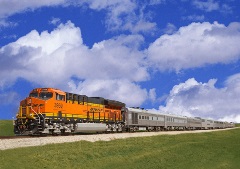
Union Station's Railroads, National World War I Museum, and Steamboat Museum
Our first visit of the day was to be to Union Station. Built in 1914, Union Station opened with 850,000 square feet of amazing space that originally featured 900 rooms. In its prime as a working train station, it accommodated hundreds of thousands of passengers each year. During World War II, an estimated one million travelers – many of them soldiers – passed through the station.
Union Station was closed in the 1980s and sat empty and neglected – narrowly escaping demolition on several occasions. In 1996, a historic bi-state initiative was passed to fund the station’s renovation, which was completed in grand fashion in 1999. We saw everything Union Station has to offer today, including the Model Railroad Experience – 8,000 square feet of model trains, from tiny N-scale models to the big G-scale giants of the model train world. This station was truly magnificent to see. By the way, there was a special presentation of an O gauge model of the station to the City while we were there by the LCCA and Lionel participated.
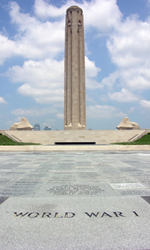 Next, we visited the only public museum in the United States solely dedicated to World War I. Following the end of World War I in 1918, the citizens of Kansas City were inspired to build a memorial in honor of those who had served in defense of liberty and our country. Local citizens raised $2.5 million dollars to design and construct the Liberty Memorial, and it formally opened in 1926. On October 28, 2004, President George W. Bush signed into law legislation formally designating Liberty Memorial as “America’s National World War I Museum.” This designation firmly establishes the Liberty Memorial Museum as THE resource for World War I in the United States. The museum features a world-class collection of historical objects and provides visitors with the opportunity to learn about WWI through the eyes of those who lived through it.
Next, we visited the only public museum in the United States solely dedicated to World War I. Following the end of World War I in 1918, the citizens of Kansas City were inspired to build a memorial in honor of those who had served in defense of liberty and our country. Local citizens raised $2.5 million dollars to design and construct the Liberty Memorial, and it formally opened in 1926. On October 28, 2004, President George W. Bush signed into law legislation formally designating Liberty Memorial as “America’s National World War I Museum.” This designation firmly establishes the Liberty Memorial Museum as THE resource for World War I in the United States. The museum features a world-class collection of historical objects and provides visitors with the opportunity to learn about WWI through the eyes of those who lived through it.
Standing watch over the Liberty Memorial high atop the 24-story tall Memorial Tower* are four carvings of the Guardian Spirits, representing the high ideals of honor, courage, patriotism, and sacrifice. The tower elevator took visitors up to the observation deck (after climbing the last 45 steps) for a dramatic view of the Kansas City skyline including Union Station.
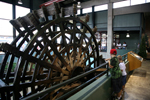 Then we had time for lunch (on our own) and shopping at the Hallmark Crown Center which also features the interactive Hallmark Cards Visitor Center. After lunch, we took a journey back through time to 1856 and the Steamboat Arabia Museum. Loaded with 200 tons of cargo, the Arabia was making her way up the Missouri River when a large log pierced her hull. Sinking in minutes, the Arabia lay entombed for the next 132 years until her remarkable recovery. During this tour we learned of the efforts and techniques leading to her salvage and saw firsthand the remarkable treasure of that era’s day-to-day goods preserved by river mud through the years. Cargo included china, jewelry, clothing, tools, firearms, spirits, bottled fruits, boots and shoes plus hundreds of other items – all in pristine condition and now beautifully displayed.
Then we had time for lunch (on our own) and shopping at the Hallmark Crown Center which also features the interactive Hallmark Cards Visitor Center. After lunch, we took a journey back through time to 1856 and the Steamboat Arabia Museum. Loaded with 200 tons of cargo, the Arabia was making her way up the Missouri River when a large log pierced her hull. Sinking in minutes, the Arabia lay entombed for the next 132 years until her remarkable recovery. During this tour we learned of the efforts and techniques leading to her salvage and saw firsthand the remarkable treasure of that era’s day-to-day goods preserved by river mud through the years. Cargo included china, jewelry, clothing, tools, firearms, spirits, bottled fruits, boots and shoes plus hundreds of other items – all in pristine condition and now beautifully displayed.
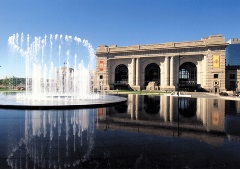
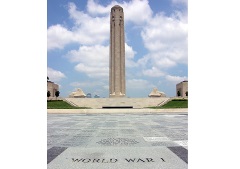
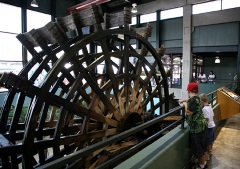
"Chicago" at the New Theatre Restaurant
A great group of attendees enjoyed an evening at Kansas City’s New Theatre Restaurant. The theatre experience began with our arrival at the theatre. We moved into the surreal park-like setting of the lobby. Bright, intermittent flashes of colorful neon radiate from recesses in the ceiling. These flashing lights were being “studied” by wall-mounted human forms, a version of trompe l’oeil, literally“fool the eye,” which created an immediate sensation that one has entered a carnival funhouse. Once inside the main theatre, our imagination took flight. Colorful Art Deco chevron-styled lighting, featuring 1,200 colored bulbs, zigzaging across the ceiling. Human forms were once again playfully posed in faux opera boxes and other locations, providing a “shadow audience.” The dining room wait staff prided itself on quick service for appetizers, salads and beverage orders. Fine dining awaited us in the “Walk through Menu,” with mouth-watering options and a delightful area on either side of the theatre where eye-popping graphics combine for more video wizardry. All of this and a great performance of the musical “Chicago” after dinner proved to be a novel and entertaining evening by all.
Kansas Speedway, Topeka's Overland Station Plus Vintage Planes & Military Vehicles
This tour began with a short drive to and around the Kansas Speedway for a brief look at Kansas City’s home to NASCAR. We made a brief drive through the oval track and stopped at one of the banked turns. Finding out first hand what a 20 degree banked incline looks like. In 1997, Wyandotte County and Kansas City, Kansas, were selected as the site for the new speedway. Located at the intersection of Interstates 70 and 435, construction began in May, 1999, on the 1.5 mile tri-oval, 75,000-seat Kansas Speedway. The speedway’s inaugural racing season was 2001 and currently hosts two annual NASCAR races.
Then we set off to Topeka, capital of the state of Kansas, to tour and have lunch at the Great Overland Station which is listed on the National Register of Historic Places as the Union Pacific Railroad Passenger Depot. Designed by renowned architect Gilbert Stanley Underwood, the Overland Station provided a beautiful setting with its soaring ceilings and intricate ornamentation. Ever-changing exhibits are designed to bring stories to life with hands-on activities, docents and photographs.
Lunch was served at the Harvey House, which is housed within the Great Overland Station. At the age of 15, Fred Harvey, an Englishman, immigrated to America and became an agent for the Burlington Railroad. As he traveled on the train, he became disgusted with the way the meals were served. In the spring of 1876, Harvey took over the restaurant at the Santa Fe depot in Topeka. Preferring the term Harvey Girl to waitress, Fred Harvey recruited single women to work at Harvey Houses along the Santa Fe Railroad line from Kansas to California. Between the 1880s and the 1950s, more than 100,000 women, many Kansan's, proudly wore the black and white uniform of the Harvey Company.
Following lunch, we headed off to visit the Combat Air and adjacent Kansas National Guard Museums. The Combat Air Museum is one of a handful of major aviation museums in the United States located on an active airfield. The museum is dedicated to the collection, preservation, conservation and exhibition of aircraft, information, artifacts, technology and art associated with the military aviation history of the United States. Exhibits at the museum include 36 aircraft ranging from WWI to present day, aircraft engines of many sizes and types and an extensive display of artifacts and military aviation art. The National Guard Museum has over 125 inside displays and 35 outside equipment displays including the M-60 main battle tank, M109A5 155mm self-propelled howitzer and a CH-54 heavy lift “Sky Crane” helicopter.
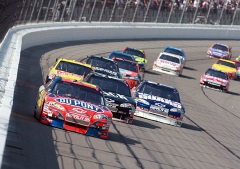
Play Ball with Kansas City Royals vs Los Angeles Angels
Founded in 1969 and based in Kansas City, Mo., the Kansas City Royals compete in Major League Baseball’s American League Central division. Since April 10, 1973, the Royals have played at Kauffman Stadium, formerly known as Royals Stadium. The Royals have participated in four World Series, winning in 1985 and 2015, and losing in 1980 and 2014.
The name “Royals” originates from the American Royal, a livestock show, horse show, rodeo, and championship barbeque competition held annually in Kansas City since 1899. Entering the American League as an expansion franchise in 1969 along with the Seattle Pilots, the club was founded by Kansas City businessman Ewing Kauffman. The franchise was established following the actions of Stuart Symington, then-U.S. senator from Missouri, who demanded a new franchise for the city after the Athletics (Kansas City’s previous major league team that played from 1955 to 1967) moved to Oakland, Calif., in 1968.
The new team quickly became a powerhouse, appearing in the playoffs seven times from 1976 to 1985, winning one World Series championship and another AL pennant, led by stars such as Amos Otis, Hal McRae, John Mayberry, George Brett, Frank White, Willie Wilson, and Bret Saberhagen. The team remained competitive throughout the early 1990s, but then had only one winning season from 1995 to 2012. The team broke this streak in 2014 with franchise’s first wild card berth and advanced to the World Series. The Royals followed this up by winning their first Central Division title in 2015 and won their first World Series title in 30 years.
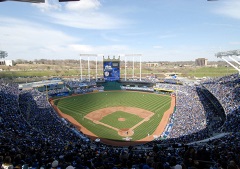
Harry Truman's Independence
This tour began with a short drive to Independence, Mo., home of our 33rd President of the United States and a visit to the Truman Library & Museum which features “Harry S. Truman: The Presidential Years” and an interactive exhibit which chronicles Truman’s presidency. The Truman Library is one of only ten in the United States administered by the National Archives and Records Administration. Consisting of research archives, there are more that 14 million pages of manuscript material stored there, including 5 million from the White House files. The museum section of the library focuses on the career of Harry S. Truman and his administration. Be sure to see the reproduction of the Oval Office as it looked during his presidency.
In addition to visiting the Truman Library, we also viewed the Old Independence Square and Courthouse (where President Truman’s office as county judge in 1933 was located) and the “Summer White House” of Harry & Bess Truman. It was at this home on June 24, 1950, that President Truman was informed that South Korea had been invaded.
Our next stop in Independence was the Chicago-Alton Depot and the adjacent National Frontier Trails Museum. Built in 1879, the depot was moved to its current location and underwent restoration from 1992 to 2002, after the Great Western Railroad threatened to demolish it. The two-story depot contains the waiting room, stationmaster’s room and baggage room on the first floor, while the second floor housed the living quarters for the stationmaster and his family.
Independence was the jumping off point for the three principal trails which crossed the West - the Santa Fe, the Oregon, and the California Trails. The Santa Fe Trail, begun in 1821, was a 900-mile foreign trade route unique in American history because it went overland rather than via water. The 2,000-mile Oregon Trail began to be heavily traveled in 1843 by settlers wanting to establish new homes in the Northwest, while others took the equally long and grueling California Trail to seek their fortunes in the gold fields. Together, these three rugged pathways and their pioneers changed the face and history of America.
A boxed lunch preceded our next visit to the Bingham-Waggoner Estate. Built in 1855 by saddle maker John Lewis and once the home of American painter George Caleb Bingham, this magnificent house has been completely restored to its original Victorian splendor. The gas chandeliers plus the furnishings and paintings of the Waggoner family, who resided here for 98 years, are beautifully displayed throughout the home.
As we returned to our hotel, we made a couple of brief detours. The first was to view the Truman Sports Complex featuring side-by-side stadiums. Arrowhead Stadium is home to the NFL’s Kansas City Chiefs while Kauffman Stadium is home to the MLB’s Kansas City Royals.
Then we continued on to SubTropolis, a 55 million square foot, 1,100-acre, manmade cave in the bluffs above the Missouri River that is claimed to be the world’s largest underground storage facility. Developed by late Kansas City Chiefs owner Lamar Hunt via Hunt Midwest Real Estate Development, Inc., it has trademarked the phrase World’s Largest Underground Business Complex. Dug into the Bethany Falls limestone mine, SubTropolis is, in part, 160 feet beneath the surface. The mine naturally maintains temperatures between 65 and 70 degrees Fahrenheit year-round. With almost seven miles of illuminated paved roads and several miles of railroad track, there currently is 5 million square feet of occupied space. About 3.2 acres of available space is added each year as active mining continues.
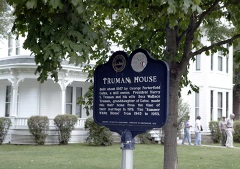
Kansas Speedway and Vintage Train Lunch
There’s fast and then there’s really fast! How’s 190 mph? Fast enough for you? That’s how fast your car needs go to qualify for the NASCAR events held at the Kansas Speedway. Twice a year NASCAR has major race weekends at the 1.5 mile Kansas City, Kan., track and also hosts Indy Car and off road events as well. We made a brief drive through the oval track and stop at one of the banked turns. Finding out firsthand what a 20 degree banked incline looks like. It will amaze you how cars at high speeds can hold to the track on these turns. This had to be seen to be believed! Then it was a short drive to Baldwin City for lunch on the Kansas Belle Dinner Train. This special three-course meal was served in a restored 1940s railcar powered by a vintage 1950s Alco RS 3 locomotive. This was a truly leisurely roundtrip to Ottawa, Kan. While the scenery may be a bit limited, we were there for the experience of train travel while eating lunch and listening to music from the 1940s. A wonderful trip!
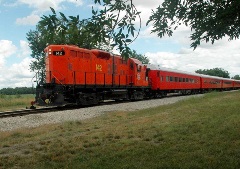
Behind the Scenes of Baseball & Jazz
Friday’s tour began with a short drive to the Truman Sports Complex, home of the Kansas City Royals and Chiefs, where we experienced a behind-the-scenes tour of Kauffman Stadium, home of the 2012 Major League Baseball All-Star Game and the 2015 World Series Champions. In addition to having the largest HD video board in baseball, “The K” features a unique outfield plaza, the Royals Hall of Fame, an interactive Kids Area and the Rivals Sports Bar. A tour of this “Crown Jewel” of ballparks took us to areas not normally open to the public including the Royals dugout, Crown Club, Press Box and visitor’s clubhouse.
Our next visit was to the historic district of 18th and Vine, home to a multiple tribute to Kansas City’s heritage, including the Negro Leagues Baseball Museum and the adjacent American Jazz Museum. The Negro Leagues Baseball Museum is the centerpiece of the historical renaissance of the Negro Leagues baseball throughout the nation. The exhibit covers the Leagues’ entire history, from its beginning after the Civil War through its final days in the 1960s. We were able to follow the history of some of baseball’s greatest legends that rose from the Negro Leagues and left an incredible mark on the game. These include household names like Willie Mays, Hank Aaron, Ernie Banks, Roy Campanella and the incredible Jackie Robinson.
The Horace M. Peterson III Visitor Center joins the Negro Leagues and American Jazz Museums. This center celebrates the African-American community that thrived at 18th and Vine for more than 40 years. While the national success of the baseball and jazz legends from this neighborhood are recognized, so too are the struggles and contributions of everyday heroes – teachers, parents, business people and clergy.
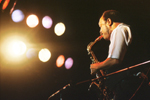 Kansas City’s role in nurturing the development of jazz during the 1920s and 1930s is known throughout the world. Kansas City “Style” was first a musical term referring to that classic blend of blues and ragtime that came to identify and explain Kansas City to millions of jazz enthusiasts. Charlie “Bird” Parker, Mary Lou Williams, Benny Moten, Hot Lips Page, Julia Lee, Baby Lovett and Count Basie with his “Kansas City Seven” were but a few of the musicians who helped nurture the Kansas City style. In addition to the interactive displays, the Kansas City Jazz Museum offers four major exhibits celebrating the memory of jazz greats Louis Armstrong, Duke Ellington, Ella Fitzgerald and Charlie Parker. These exciting exhibits included audio and video stations as well as memorabilia from the performers – including Charlie Parker’s famous plastic saxophone.
Kansas City’s role in nurturing the development of jazz during the 1920s and 1930s is known throughout the world. Kansas City “Style” was first a musical term referring to that classic blend of blues and ragtime that came to identify and explain Kansas City to millions of jazz enthusiasts. Charlie “Bird” Parker, Mary Lou Williams, Benny Moten, Hot Lips Page, Julia Lee, Baby Lovett and Count Basie with his “Kansas City Seven” were but a few of the musicians who helped nurture the Kansas City style. In addition to the interactive displays, the Kansas City Jazz Museum offers four major exhibits celebrating the memory of jazz greats Louis Armstrong, Duke Ellington, Ella Fitzgerald and Charlie Parker. These exciting exhibits included audio and video stations as well as memorabilia from the performers – including Charlie Parker’s famous plastic saxophone.
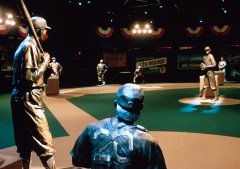
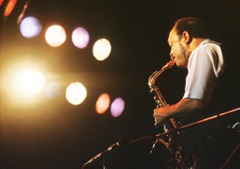
Home Layout Tours
From the Electric Express first built in 1900 to the most elaborate and sophisticated layouts of the current day, Lionel Trains have brought smiles and happiness to both old and young for over a century! Collectors with a meticulous touch keep their layouts fine-tuned and up-to-date with the latest trends in the Lionel legacy. Such attention to detail will be on display in the three layout tours selected for tour visitors.
The first stop was in Overland Park, Kan., home of Andy Dubil. Santa delivered Andy his first Lionel train set in 1956, and Andy has recaptured the spirit of those days with his layout he and his eight grandchildren enjoy today. All were impressed with the detail of the layout, and not to mention Andy's impressive train collections as well as his other collectibles on display.
Moving on to the next impressive layout, our next stop was just a short drive away and the engines were humming through this multi-room tour. Don Miller’s scenic postwar collection had it all, from mountainous areas to cities and amusement parks. Both Andy and Don have been instrumental in getting a local train club started in the Kansas City area and are involved with the Train Collectors Association (TCA) well as the LCCA.
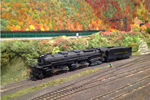 Finally the tour lead us to Jim and Ruth Eudaly’s home in nearby Kansas City, Mo. There we found a massive layout of the New River Gorge in West Virginia. Each bend in the river was true to scale, complete with actual replicas of depots and coal mines from the area. This impressive layout also has over 2000 handmade trees and shrubs made by Ruth. Together they have created a masterpiece that needs to be seen to be believed!
Finally the tour lead us to Jim and Ruth Eudaly’s home in nearby Kansas City, Mo. There we found a massive layout of the New River Gorge in West Virginia. Each bend in the river was true to scale, complete with actual replicas of depots and coal mines from the area. This impressive layout also has over 2000 handmade trees and shrubs made by Ruth. Together they have created a masterpiece that needs to be seen to be believed!
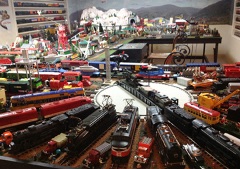
Crown Center & Country Club Plaza Shopping
For our Saturday morning excursion, we were off to Crown Center Shopping Complex, home of the Hallmark Visitors Center. The shopping and entertainment complex featured three levels of shops and restaurants, a set of grand open air fountains, live theatres, an ice skating rink and over-street walkways leading throughout the complex and to Kansas City’s Union Station. One of the most notable stores is the Halls department store designed by Paul La´szlo´. At the Hallmark Visitors Center, we traveled through the Hallmark Cards’ story and the humble beginnings of its founder, Joyce C. (“Mr. J.C.”) in 1910. We also traveled to the world famous Country Club Plaza. Modeled on Seville, Spain by developer J. C. Nichols, the Country Club Plaza was constructed in the late 1920s. Encompassing over 55 acres, The Plaza is home to over 180 upscale shops, cafe´s and restaurants including Pandora, Kate Spade of New York, Vera Bradley, Tiffany & Co., H&M, The Coach Store, Tivol, Sur La Table, Michael Kors and Cole Haan. We had time to visit our choice of the many stores, boutiques and dining establishments before we returned to our hotel in time for lunch.
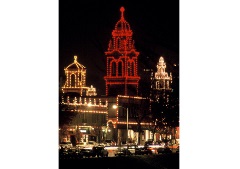
Significant Convention events also held were:
- Annual business meeting
- Lionel seminar
- Informational seminars and hobby clinics
- Junior member activities for young club members
- Famous "Get Acquainted Party"
- President's Welcoming Reception
- Reception for first-time attendees
- Saturday evening reception and banquet
July 25-30, 2016, was a great memorable time. However, we can look forward now to the model railroad train shows, camaraderie and more at the Tacoma Convention in 2017.
These events held in Kansas City are just a taste of the type of things in store for you, your family, and friends when you come to an LCCA convention and help us celebrate the annual anniversary of the "Best toy train club on the planet" by making each convention one of the best in Lionel Collectors Club Convention history. Members may register online for the Tacoma Convention in February 2017 or read the details of the events published in The Lion Roars, the club’s model train magazine. Non-members may join the club now and be prepared for a fabulous week of fun, great food, toy train shows and friendship with train operators and collectors who favor the Lionel brand and celebrate the world’s greatest hobby.
